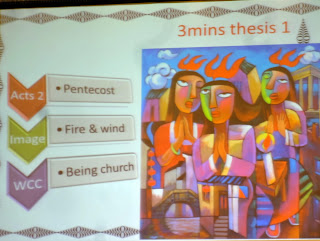Today's worship used one of the most common biblical images: food. God opens his hands and fills all living creatures with nourishment. God feeds the church at the Eucharist. Feeding the hungry is a fundamental call of the Christian life.
In today's prayer the Scripture lesson was taken from 1 Kings 21:1-22. It is a story of struggle for justice. Justice for those who are dispossed of their lands, dispossed of their rights, dispossed of their means of sustenance.
The prayer of confession and repentance was very forceful:
--when we ignore the beauty of creation;
--when trees are torn down and forests become deserts;
--when bees die and mango trees no longer have fruit;
--when we mine the land for its gold and oil yet millions have no food;
--when we know what we should do yet walk the other way
how terrible for us.
God of creation,
hear the confession of our hearts.
Send your Spirit to renew the whole creation
as we proclaim the everlasting love of your Son.
Amen.
The refrain of the closing hymn went like this:
Until all are fed! We cry out; until all on earth have bread. Like the One who loves us each and every one; we serve until all are fed.
Bible study: Struggles for justice in an ambiguous world
At first glance the text chosen was very difficult to get into. We had a lot of good discussion but often times no consensus on how to interpret the text.The characters in the story include Jezebel, a princess from Phoenicia who is brought to the northern kingdom of Israel to marry King Ahab Jexebel's deity was Baal while the king's was Yahweh (but he later converts to his wife's). When the king wanted the vineyard of Naboth and is refused, Jezebel goes into action hatching a plot to kill Naboth. Her reasoning was that the King could do whatever he wanted since he was king.
 |
| Small group discussions during the Bible study |
The reason why Naboth will not give the land is because it is the inheritance given by Yahweh to his ancestors. To make a long story short, Jazebel had Naboth accused of blasphemy and stoned, The prophet Elizah is sent by Yahweh to deal with Ahab by cursing him because he caused the wrath of God and caused Israel to sin.
In the context of today's work in the Assembly on justice, questions concerning the inheritances and rights of people were posed.
 |
| Madang setting for the justice plenary |
Speaking on economic injustice and the dispossession of people's ancestral lands was Mr. Martin Khor.
In a very passionate presentation on the injustice in witholding vital medicines from those in poorer countries especially in light of HIV Aids was Rev. Phumzile Mabizela. The cost of such medication is so prohibative that poor people cannot afford the medication and eventually end up dying. She also emphasized that their is no reason for children to be born HIV positive. However, unless people can obtain the expensive medication in Africa there is still a large percentage of children being born HIV positive.
The other participants spoke about the necessity for theological reflection on this issues as they relate not only to justice but also to the unity of the church. The churches need to recoginzie the moral imperative of confronting justice as an integral part of "costly discipleship". Here is where the churches can make a difference by working together in the public arena for the cause of justice. By doing so together they also make an important statement about unity.
 |
| With Walker-Smith is Julia Duchrow, Bishop Iosif of Patrara, Mabziela and Martin Khor |
The afternoon was pretty much business with the election of the Central committee and the hearing of the reports and statements that need to be received.
The session began with a choir of young children who sang about protecting each other's rights.
The new 150-person Central Committee counts women: 39%, men: 61%, youth: 13%, indigenous persons: 5%, persons with disabilities: 2%, ordained: 68%, and 32% of the members of the committee are lay persons. The nominations committee worked with a pool of names put forward by the WCC's 345 member churches. A 25-person executive committee, a moderator and two vice-moderators will be elected by the Central Committee later this week. You can see the list by cliking on the link
http://www.oikoumene.org/en/about-us/organizational-structure/central-committee/NC032FINALMembersoftheCentralCommitteeasElectedbythe10thAssembly.pdf
SEDOS
Since today 's theme dealt with justice, I want to share with you news on an organization of religious communities who all have as their apostolate mission
Peace and all good.































